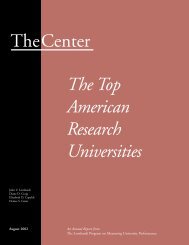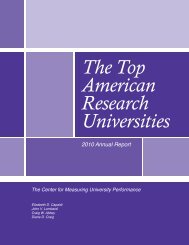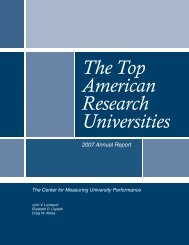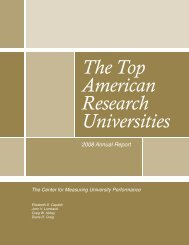TheCenter The Top American Research Universities
2005 - The Center for Measuring University Performance - Arizona ...
2005 - The Center for Measuring University Performance - Arizona ...
You also want an ePaper? Increase the reach of your titles
YUMPU automatically turns print PDFs into web optimized ePapers that Google loves.
Table 5: Institutions In and Out of the <strong>Top</strong> 20 with ASEE Engineering Expenditures Removed (2003)InstitutionNSF Total($000)NSF RankChange in RankNSF less ASEEExp.Johns Hopkins University 1,106,971 1 1University of Washington - Seattle 565,602 2 2University of Michigan - Ann Arbor 516,818 3 3Stanford University 483,540 4 4University of California - Los Angeles 421,174 5 6University of Pennsylvania 415,631 6 5University of California - San Diego 400,100 7 9University of Wisconsin - Madison 396,231 8 10Columbia University 385,529 9 7Washington University in St. Louis 357,364 10 8Massachusetts Institute of Technology 356,206 11 24 OutHarvard University 348,620 12 11University of Pittsburgh - Pittsburgh 345,625 13 12Duke University 306,864 14 15University of Southern California 300,195 15 23 OutYale University 296,713 16 13University of Minnesota - Twin Cities 293,266 17 16University of North Carolina - Chapel Hill * 280,678 18 14Pennsylvania State University - University Park 270,985 19 22 OutUniversity of Illinois - Urbana-Champaign 266,487 20 60 OutUniversity of Arizona 259,074 21 17 InUniversity of Alabama - Birmingham 245,217 22 18 InEmory University * 228,255 25 19 InVanderbilt University 221,979 26 20 In* Campuses without ASEE engineering school.In / Out<strong>Top</strong> 20NSF rank: the rank with medicine removed and therank with engineering removed. Simple inspectionof this display suggests some observations that arefamiliar to those who have followed our conversationon the subject of university rankings over the years.As Figure 2 illustrates, at the high end of the totalNSF research rankings, removing the medicine andengineering contributions to research expendituresdrops the ranking considerably, reflecting the importanceof medicine, in particular, in driving theresearch performance of these top institutions. Institutionsin the lower half of the distribution by totalNSF expenditures tend to improve their position withmedicine and engineering removed. This reflects therelatively smaller part of these institutions’ total NSFdollars contributed by medicine and engineering.When medicine and engineering disappear from thetotals of the highly competitive institutions, previouslyless-competitive institutions improve their score.While the rankings analysis helps us understandthe components that influence rankings, and urgecaution in placing too much confidence in the meaningof relatively small changes in relative rank, thepercentage of an institution’s total research that comesfrom the medical school as reported in AAMC dataoffers another perspective on the dramatic variationin the importance of a medical school to individualcampuses.Of the 149 campuses in our data set, 71 havemedical schools, and the medical school contributionto the campus total research expenditure of those 71institutions ranges from a high of 100% to a low under1%. Figure 3 (see page 18) illustrates the relationshipbetween medicine’s percentage of an institution’stotal federal research expenditures and the changein rank that occurs when we remove those medicineexpenditures from the total. Not surprisingly, whenmedical research is a large percentage of a campus’research enterprise, it loses position relative to thoseuniversities without medical schools or whose medicalschools do not produce much federal research.<strong>The</strong> <strong>Top</strong> <strong>American</strong> <strong>Research</strong> <strong>Universities</strong> 2005 Page 15








